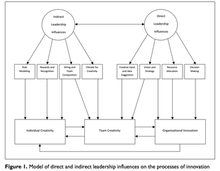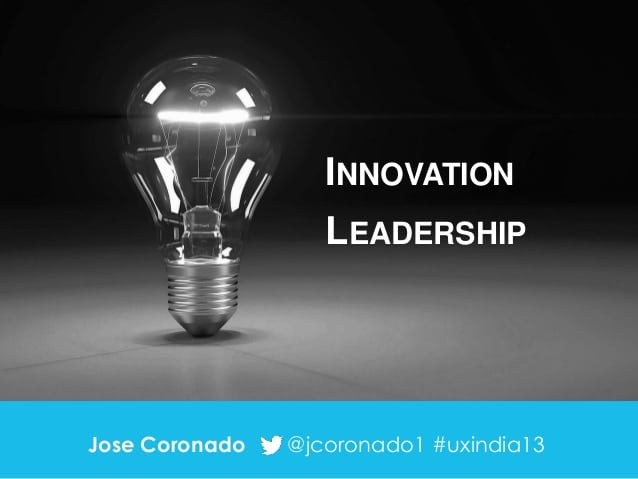Социально-психологический
климат на ИП в значительной степени
зависит от господствующего на нем стиля
руководства. Под стилем
руководства принято
понимать виды и способы выполнения
менеджером управленческих функций,
которые находят выражение в отношениях
с подчиненными. Понятие стиля руководства
теснейшим образом связано с категорией
лидерства в управлении, т. е. способности
руководителя влиять на отдельные
личности или группы людей, побуждая их
к деятельности, направленной на достижение
целей организации. Стремясь к обеспечению
лидерства, менеджер использует
разнообразные способы воздействия на
подчиненных и коллег. В зависимости от
преимущественного предпочтения этих
способов и их комбинации выделяют
различные стили руководства. Принципиальное
значение при их систематизации имеют
признаки целевой ориентации, объема и
форм организации руководства.
По признаку
целевой ориентации можно выделить две
категории стилей руководства творческим
коллективом в инновационной сфере:
руководство, ориентированное на задачи,
и руководство, ориентированное на
сотрудников. Первая категория настроена
на обеспечение достижения установленных
целей инновационной деятельности путем
строгого соблюдения процедур планирования,
организации и контроля на ИП. Руководство,
ориентированное на сотрудников,
предполагает создание наиболее
благоприятных условий для творческого
труда на ИП и использует преимущественно
методы делегирования, мотивации и
коммуникаций для регулирования
человеческих отношений в коллективе.
Естественно, на практике речь идет об
определенном сочетании этих двух
экстремальных вариантов. Объем
управленческой деятельности на ИП
зависит °т количества сотрудников,
принимающих в ней участие. Степень
участия сотрудников в управлении
инновациями характеризует определенный
стиль Руководства инновационной
деятельностью. Различают два полярных
по этому признаку стиля руководства:
авторитарный и коллективный (или
кооперативный).
В чистом виде
полярные по объему стили руководства
встречаются крайне редко. На практике
степень участия сотрудников может
меняться на различных стадиях проявления
волевых решений при осуществлении
инновационных процессов. Модель
формирования стиля руководства по этому
признаку можно представить как
морфологическую матрицу сочетаний
монополярных (авторитарных) и мультиполярных
(коллективных) способов формирования
проблем, принятия управленческих решений
и их реализации.
Форма организации
руководства зависит от того, насколько
официально регламентированы отношения
менеджера с персоналом ИП. По этому
признаку различают формальный и
неформальный стили руководства.
Формальный стиль руководства возможен
при строгом регламентировании для всех
участников инновационного процесса их
задач, уровня компетенции и ответственности
по всем осуществляемым проектам и
работам
Неформальный
стиль руководства возникает при
невозможности (ввиду многочисленности
участников или сложности структуры)
или нецелесообразности (вследствие
краткосрочности образования структуры)
полностью регламентировать управленческие
функции в менеджменте ИП. Неформальный
стиль руководства оставляет для менеджера
значительно большую степень свободы,
однако требует от него и больших усилий,
авторитета и профессиональных навыков.
В практике на ИП не встречаются в чистом
виде формальные или неформальные стили
руководства В вертикальных связях и
коммуникациях стараются реализовать
формальный стиль руководства, в то время
как горизонтальные коммуникации
осуществляются без строгой регламентации.
Рассмотренные
признаки целевой ориентации, объема и
формы организации руководства на ИП
выступают во взаимосвязи, образуя
наиболее эффективную систему отношений
и формируя комфортный психологический
климат в творческом коллективе.
Прогрессивные формы руководства в
инновационном менеджменте все чаще
приобретают признаки демократичного
стиля, обеспечивающего значительный
простор для инициативы каждого участника
инноваций и групповых решений.
Соседние файлы в предмете [НЕСОРТИРОВАННОЕ]
- #
- #
- #
- #
- #
- #
- #
- #
- #
- #
- #
Скачать материал

Скачать материал




- Сейчас обучается 26 человек из 16 регионов


аудиоформат


Описание презентации по отдельным слайдам:
-
1 слайд
Стиль руководства и Лидерство в инновационных организациях
Подготовили студенты группы 9551:
Калязина. А.
Степанов. С. -
2 слайд
Под стилем руководства принято понимать совокупность всех методов, приемов, действий, которые использует руководитель в своей деятельности.
Каждый руководитель отличается собственным индивидуальным стилем, однако это не исключает возможностей обобщения стилей разных менеджеров.
-
3 слайд
Принято делить руководителей на «автократов» и «демократов», однако такое разделение весьма условно и трудно встретить представителей этих стилей в «чистом виде».
-
4 слайд
Индивидуальность стилей проявляется, прежде всего, в процессе общения менеджера с персоналом и тесно связана с категорией лидерства в управлении, то есть способностью руководителя влиять на отдельные личности или группы людей, побуждая их к деятельности для достижения целей организации.
-
5 слайд
По признаку целевой ориентации различают две категории стилей руководства в инновационной сфере:
руководство, ориентированное на задачу
руководство, ориентированное на сотрудников -
6 слайд
Степень участия сотрудников в управлении инновациями характеризует определенный стиль руководства инновационной деятельностью.
Различают два полярных по этому признаку стиля руководства: авторитарный и коллективный (или кооперативный). Общая характеристика этих стилей руководства приведена на рисунке.
-
7 слайд
Децентрализация личной власти руководителя не лишает соответствующей его должности полноты власти и ответственности за инновационную деятельность на предприятии.
Таким образом, форма организации руководства зависит от того, насколько официально регламентированы отношения менеджера с персоналом ИП. По этому признаку различают формальный и неформальный стили руководства
-
8 слайд
Структурная жесткость, или формальный стиль руководства, предполагает делегирование полномочий, официально закрепленных в документах; наличие системы стратегического и текущего планирования инновационных исследований; отлаженного механизма коммуникаций и обмена информацией.
-
9 слайд
Поведенческая мягкость, или неформальный интерактивный стиль руководства, расширяет свободу научно-технических кадров в принятии решений, т.е. создает ситуацию, когда строгая регламентация управленческих функций нецелесообразна, поскольку сотрудники с высоким творческим потенциалом решают проблемы вне установленных парадигм.
-
10 слайд
Источниками воздействия харизматичных руководителей являются:
1) четкое видение будущего, который подразделяется сотрудниками;
2) создание системы корпоративных ценностей, которые поддерживаются всеми работающими
3) взаимное доверие лидера и сотрудников.
Харизматических лидеров, которые имеют особые способности по управлению внедрением инноваций, называют трансформируя руководителями -
11 слайд
Прогрессивные формы руководства в инновационном менеджменте обеспечивают простор для инициативы каждого участника инноваций, групповых решений и влияют на формирование инновационной культуры в организации.
-
12 слайд
культура организации представляет собой сложную композицию важных базовых ценностей, норм, соглашений, философии управления, моделей поведения, разделяемые всеми членами организации, сознательно желают выполнять возложенные на них требования.
технократическая модель общественного прогресса себя исчерпала и вектор качественного развития, обновление цивилизации определяет именно инновационная культура.
-
13 слайд
инновационная культура
результат социальных взаимодействий и передается через обучение, многочисленные контакты между группами людей, поведение, установки, нормы, систему ценностных ориентаций, манеры одеваться, этику трудовых отношений, символы, стиль руководства, церемонии, коммуникации, язык. -
14 слайд
мотивированность рабочих к знаниям и разработки инноваций;
— нацеленность на результат;
работа в команде;
стремление достичь высокого профессионализма;
возможность общения с коллегами на семинарах, выставках, конференциях (вне работы);
свобода выражения мнений, идей;
свобода творчества.По мнению Стивена Робинса сущность инновационной культуры организации раскрывается в таких характеристиках, как:
-
15 слайд
Фатхутдинов Р.А. Инновационный менеджмент — М.: Питер, 2009 — с.208
Ивасенко Н.А. Инновационный менеджмент — М.: ИНФРА-М, 2004 — с.206.
Имидж лидера. // Под ред. Егоровой Е. — М., 2004. — с.57
Абрамешин А.Е. Инновационный менеджмент — М.: Европейский центр по качеству, 2003 — с.275Список Литературы
-
16 слайд
Спасибо за внимание
Найдите материал к любому уроку, указав свой предмет (категорию), класс, учебник и тему:
6 220 697 материалов в базе
- Выберите категорию:
- Выберите учебник и тему
- Выберите класс:
-
Тип материала:
-
Все материалы
-
Статьи
-
Научные работы
-
Видеоуроки
-
Презентации
-
Конспекты
-
Тесты
-
Рабочие программы
-
Другие методич. материалы
-
Найти материалы
Другие материалы
- 05.12.2019
- 199
- 0
- 05.12.2019
- 256
- 0
- 05.12.2019
- 161
- 0
- 05.12.2019
- 282
- 2
- 05.12.2019
- 196
- 0
- 05.12.2019
- 526
- 5
- 05.12.2019
- 236
- 3
- 05.12.2019
- 278
- 1
Вам будут интересны эти курсы:
-
Курс повышения квалификации «Облачные технологии в образовании»
-
Курс повышения квалификации «Средства педагогического оценивания и мониторинга в работе учителя в условиях реализации ФГОС»
-
Курс повышения квалификации «Специфика преподавания гражданского права с учетом реализации ФГОС»
-
Курс повышения квалификации «Основы педагогического дизайна»
-
Курс повышения квалификации «Становление и развитие профессионального сознания в контексте введения профессионального стандарта»
-
Курс повышения квалификации «Организация и проведение культурно-досуговых мероприятий в соответствии с ФГОС ДО»
-
Курс повышения квалификации «Применение современных педагогических технологий в образовательном процессе в условиях реализации ФГОС»
-
Курс профессиональной переподготовки «Тьюторское сопровождение в образовательных организациях»
-
Курс повышения квалификации «Образовательная кинезиология в практике психолого-педагогического сопровождения учащихся в условиях реализации ФГОС»
-
Курс профессиональной переподготовки «Государственно-правовые дисциплины: теория и методика преподавания в образовательной организации»
-
Курс повышения квалификации «Методическая работа преподавателя вуза в современных условиях»
-
Курс повышения квалификации «Формирование и развитие ключевых компетенций школьников в интересах устойчивого развития региона»
-
Курс повышения квалификации «Инструменты и методы воспитания российской гражданской идентичности согласно ФГОС»
Слайд 1
Стиль руководства и Лидерство в инновационных организациях
Подготовили студенты группы 9551:
Калязина. А.
Степанов.

Слайд 2Под стилем руководства принято понимать совокупность всех методов, приемов, действий, которые
использует руководитель в своей деятельности.
Каждый руководитель отличается собственным индивидуальным стилем, однако это не исключает возможностей обобщения стилей разных менеджеров.

Слайд 3Принято делить руководителей на «автократов» и «демократов», однако такое разделение весьма
условно и трудно встретить представителей этих стилей в «чистом виде».

Слайд 4Индивидуальность стилей проявляется, прежде всего, в процессе общения менеджера с персоналом
и тесно связана с категорией лидерства в управлении, то есть способностью руководителя влиять на отдельные личности или группы людей, побуждая их к деятельности для достижения целей организации.
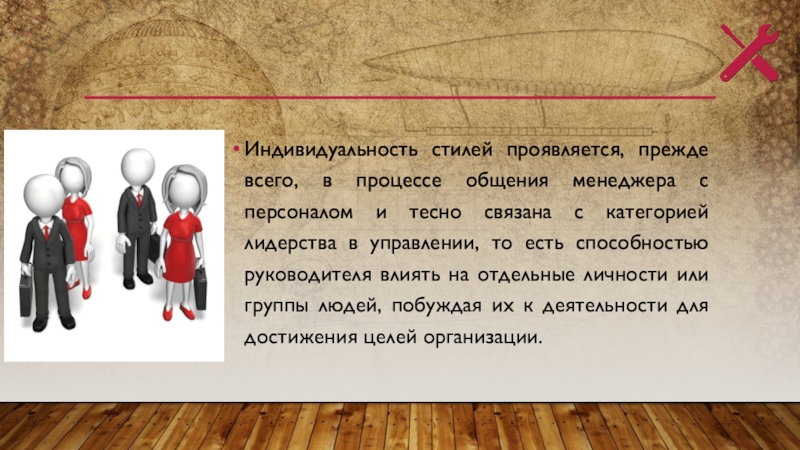
Слайд 5По признаку целевой ориентации различают две категории стилей руководства в инновационной
сфере:
руководство, ориентированное на задачу
руководство, ориентированное на сотрудников
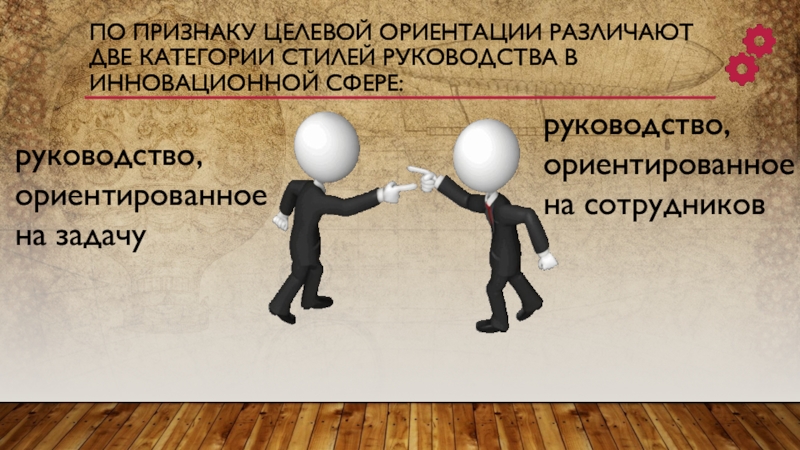
Слайд 6Степень участия сотрудников в управлении инновациями характеризует определенный стиль руководства инновационной
деятельностью.
Различают два полярных по этому признаку стиля руководства: авторитарный и коллективный (или кооперативный). Общая характеристика этих стилей руководства приведена на рисунке.
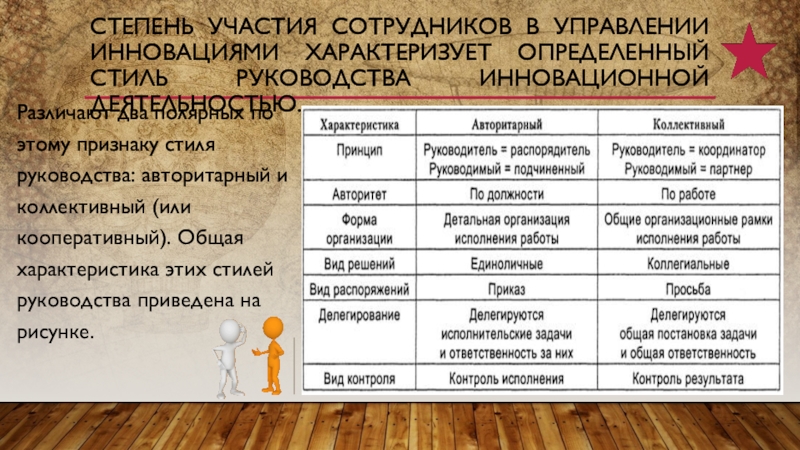
Слайд 7Децентрализация личной власти руководителя не лишает соответствующей его должности полноты власти
и ответственности за инновационную деятельность на предприятии.
Таким образом, форма организации руководства зависит от того, насколько официально регламентированы отношения менеджера с персоналом ИП. По этому признаку различают формальный и неформальный стили руководства

Слайд 8Структурная жесткость, или формальный стиль руководства, предполагает делегирование полномочий, официально закрепленных
в документах; наличие системы стратегического и текущего планирования инновационных исследований; отлаженного механизма коммуникаций и обмена информацией.
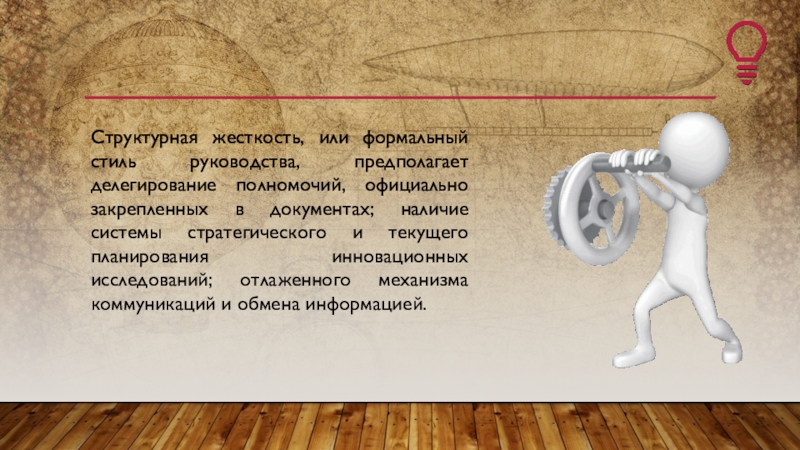
Слайд 9Поведенческая мягкость, или неформальный интерактивный стиль руководства, расширяет свободу научно-технических кадров
в принятии решений, т.е. создает ситуацию, когда строгая регламентация управленческих функций нецелесообразна, поскольку сотрудники с высоким творческим потенциалом решают проблемы вне установленных парадигм.
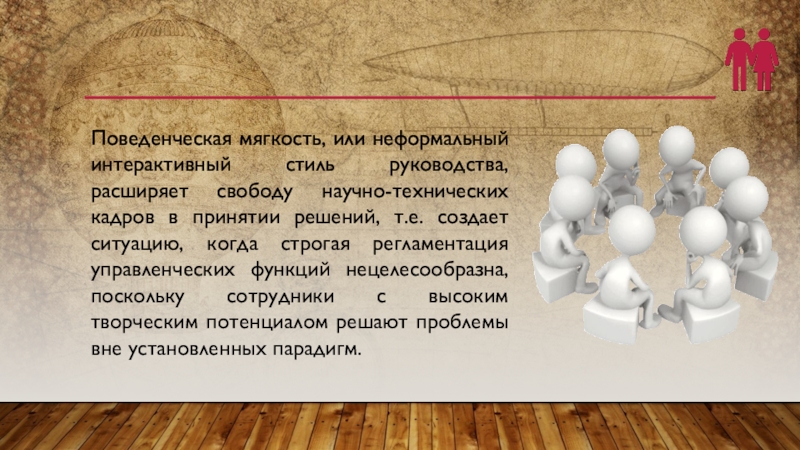
Слайд 10Источниками воздействия харизматичных руководителей являются:
1) четкое видение будущего, который подразделяется сотрудниками;
2)
создание системы корпоративных ценностей, которые поддерживаются всеми работающими
3) взаимное доверие лидера и сотрудников.
Харизматических лидеров, которые имеют особые способности по управлению внедрением инноваций, называют трансформируя руководителями
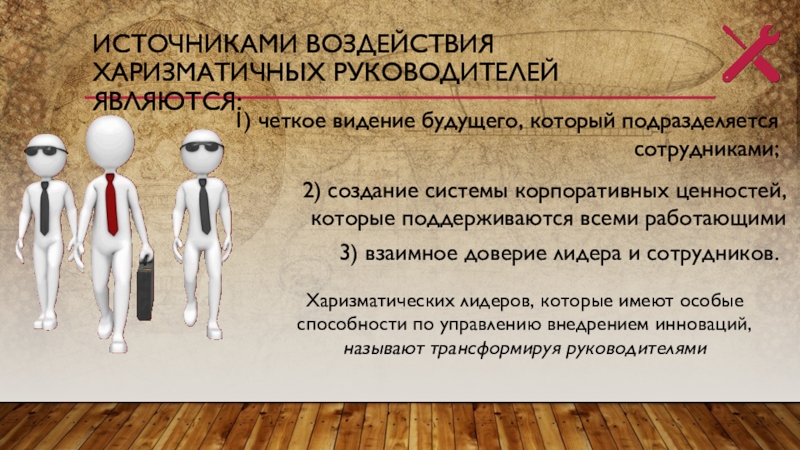
Слайд 11Прогрессивные формы руководства в инновационном менеджменте обеспечивают простор для инициативы каждого
участника инноваций, групповых решений и влияют на формирование инновационной культуры в организации.

Слайд 12культура организации представляет собой сложную композицию важных базовых ценностей, норм, соглашений,
философии управления, моделей поведения, разделяемые всеми членами организации, сознательно желают выполнять возложенные на них требования.
технократическая модель общественного прогресса себя исчерпала и вектор качественного развития, обновление цивилизации определяет именно инновационная культура.

Слайд 13инновационная культура
результат социальных взаимодействий и передается через обучение, многочисленные контакты
между группами людей, поведение, установки, нормы, систему ценностных ориентаций, манеры одеваться, этику трудовых отношений, символы, стиль руководства, церемонии, коммуникации, язык.

Слайд 14 мотивированность рабочих к знаниям и разработки инноваций;
— нацеленность на результат;
работа в команде;
стремление достичь высокого профессионализма;
возможность общения с коллегами на семинарах, выставках, конференциях (вне работы);
свобода выражения мнений, идей;
свобода творчества.
По мнению Стивена Робинса сущность инновационной культуры организации раскрывается в таких характеристиках, как:
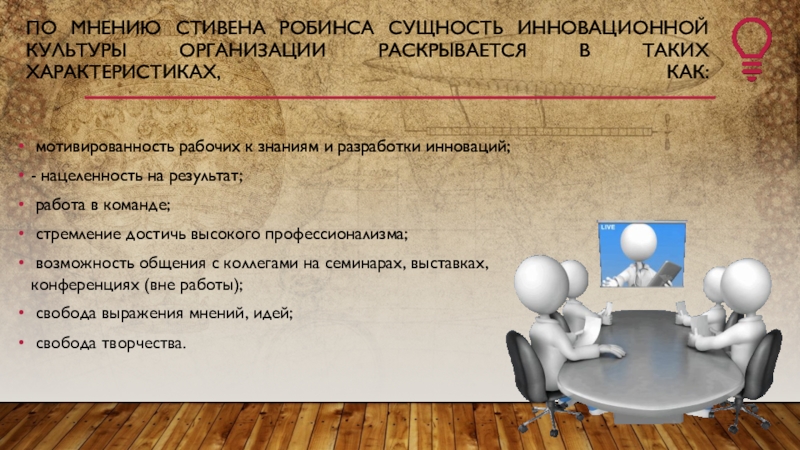
Слайд 15Фатхутдинов Р.А. Инновационный менеджмент — М.: Питер, 2009 — с.208
Ивасенко Н.А.
Инновационный менеджмент — М.: ИНФРА-М, 2004 — с.206.
Имидж лидера. // Под ред. Егоровой Е. — М., 2004. — с.57
Абрамешин А.Е. Инновационный менеджмент — М.: Европейский центр по качеству, 2003 — с.275
Список Литературы
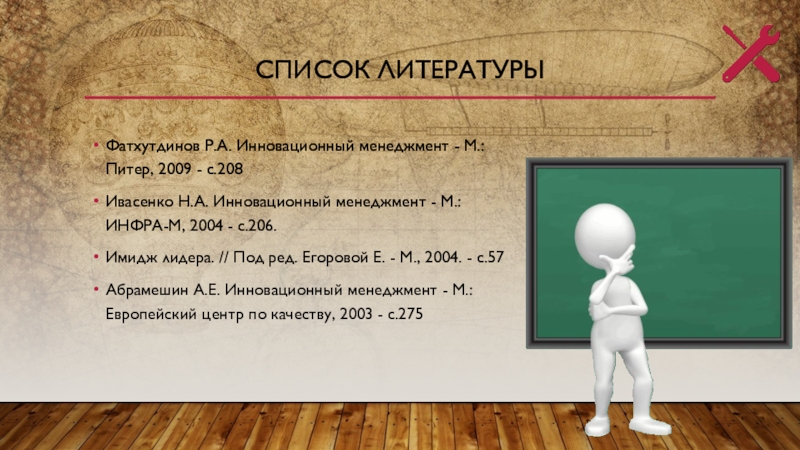
Innovation leadership is a philosophy and technique that combines different leadership styles to influence employees to produce creative ideas, products, and services. The key role in the practice of innovation leadership is the innovation leader.[1] Dr. David Gliddon (2006) developed the competency model of innovation leaders and established the concept of innovation leadership at Penn State University.
As an approach to organization development, innovation leadership can support achievement of the mission or the vision of an organization or group. With new technologies and processes, it is necessary for organizations to think innovatively to ensure continued success and stay competitive.[2][3][4][5][6] to adapt to new changes, “The need for innovation in organizations has resulted in a new focus on the role of leaders in shaping the nature and success of creative efforts.[7]” Without innovation leadership, organizations are likely to struggle.[3] This new call for innovation represents the shift from the 20th century, traditional view of organizational practices, which discouraged employee innovative behaviors, to the 21st-century view of valuing innovative thinking as a “potentially powerful influence on organizational performance.”[8]
Overview[edit]
To have a clear understanding of what innovation leadership involves, one must first understand the concept of innovation. Although there is some controversy over how it can be defined, through general consensus in the literature, it can be described as novel ideas of viable products that are put into operation.[9] It includes three different stages, which are all dynamic and iterative (constant):
- Idea Generation
- Evaluation
- Implementation
The two types of innovation include exploratory innovation, which involves generating brand new ideas, and value-added innovation, which involves modifying and improving ideas that already exist.[10][11][12][13] Ideas generated must be useful to be considered innovative. Innovation should also not be confused with creativity, which is merely the generation of a novel idea that may not necessarily be put into operation—though these words are sometimes used interchangeably in research literature when speaking about innovation leadership. Innovation leadership is a complex concept, as there is no single explanation or formula for a leader to follow to increase innovation. As a result, innovation leadership encompasses a variety of different activities, actions, and behaviors that interact to produce an innovative outcome.
Value-added innovation[edit]
Exploratory and value-added innovation require different leadership styles and behaviors to succeed. Value-added innovation (PwC, 2010) involves refining and revising an existing product or service and typically requires minimal risk taking (compared to exploratory innovation, which often involves taking a large risk); in this case, it is most appropriate for a leader for innovation to adopt a transactional form of leadership.[11][15] This is because a transactional leadership style does not use open leadership behaviors such as encouraging employees to experiment and take risks, but rather uses closed leadership behaviors that do not condone or reward risk-taking. Companies whose innovation leaders use transactional leadership for value-added innovation purposes include Toyota Motor Co., General Motors Corp., and Ford Motor Co.;[15] examples of these companies’ value-added innovations such as making improvements on existing cars by making them faster, more comfortable, and getting better gas mileage.
Occasionally a value-added innovation may require a completely new way of thinking and possibly taking new risks. An example of this scenario can be illustrated through Aspirin; this was an existing product, traditionally used as an analgesic to alleviate aches and pains, but has been introduced into a new and different market by extending its uses to help prevent heart attack and reduce blood clot formation. In this example, the usage of an existing product was re-worked and introduced into a new market. While an existing product is being changed and/or improved upon, characterizing it as a value-added innovation, outside-the-box thinking, research, and risk-taking are now required since it is being introduced into a new market. In this case, a transformational leadership style is a more appropriate style to use.
The innovation leader must gauge if (and how much) risk and radical thinking are involved in the value-added innovation to determine which leadership style to use in a situation. The leader must be flexible—able to switch leadership behaviors when necessary.
Exploratory innovation[edit]
Exploratory innovation refers to the generation of novel ideas, strategies, and solutions through the use of strictly open behaviors exhibited most often by transformational leaders. The foundation of exploratory innovation is characterized by search, discovery, experimentation, and risk taking. It is the organization’s focus on generating new ideas, products and strategies; in contrast to exploitative innovation, which focuses on building and extending already existing ideas. Some studies have shown that explorative and exploitative innovation require different structures, strategies, processes, capabilities, and cultures.[16] See Innovative Organizational Climate/Culture. Exploratory innovation requires flexibility, opportunism, adaptability, and for leaders to provide intellectual stimulation to their subordinates.[11] In this approach to innovation, the leadership style that is primarily used is transformational. The behaviors exhibited are believed to achieve the desired creative outcome from employees through the application of individualized consideration, charisma, and inspirational motivation.
For example, in one study of the innovation practices at AXA Insurance in Ireland, the CEO John O’Neil engaged in transformational leadership behaviors and introduced the “MadHouse” program that combined workers from different departments and levels of the organization to work together in a creative way. The result of this experiment after six months was 150 new business ideas for products and services.[17] Explorative and Value-added innovation are often referenced together, but surprisingly little research shows an interaction between the two. However, there is an understanding that in some circumstances a ‘balance’ must be attained to achieve superior employee performance.[6] For example, not all novel ideas are implemented, and may be resurrected later. The organization may need to switch gears and adopt exploitative strategies to revise and refine the idea to match present needs.
Foundations[edit]
Innovation leadership has roots in path-goal theory and leader-member exchange theory. Certain elements within an organization are also needed for innovation leadership to succeed. Wolfe (1994),[18] as cited by Sarros, Cooper, & Santora, (2008)[4] has pointed out that one antecedent factor for innovation is organizational culture. Likewise, Isaksen, Laver, Ekvail & Britz (2001) [19] concur that innovative endeavors fail without a supportive climate. This antecedent of a supportive organizational culture/climate encompasses encouragement of creativity, autonomy, resources, and pressures. Additional foundational elements for innovation leadership include creative work, a creative workforce, and certain leader attributes.[8]
Roots in path-goal theory[edit]
The basis of path-goal theory uses a similar view of leadership, in that it advocates different types of leadership (e.g., participative, supportive) behaviors, much like innovation leadership does. However, it is contingent on employee and environmental factor to be effective.[20][21] The idea of a single leader using different leadership behaviors originated in path-goal theory, and has been associated with the framework underlying innovation leadership, which also allows the creation of a work environment conducive to innovative thinking—which is the cognitive process of generating novel and useful ideas.
Creating this type of work environment through innovation leadership involves open leadership behaviors that resemble some leader behaviors proposed by Path-goal theory—for example, upward influence and supportive/considerate behaviors.[20] In innovation leadership, these behaviors encourage the creative team to generate as many novel ideas as possible and lead to evaluation and implementation of these ideas.[11]
Roots in leader-member exchange theory[edit]
Leader-member exchange theory (LMX theory) is another one of the building blocks of innovation leadership. It follows the same idea as Path-goal theory and innovation leadership, that multiple leadership styles are necessary in managing multiple subordinates but takes it a step further. LMX involves adopting a unique leadership style for each employee. Past studies indicate that LMX theory has been shown to have an effect on innovation.[22][23] Studies have also shown that leader-member exchange relationships can predict significant organizational and attitudinal variables including higher job satisfaction and higher job performance.
Basu and Green (1997)[22] found that innovative behavior is related to the quality of the leader-member exchange where high quality exchanges include contributions from both the leader and the follower. However, in a study by Jean Lee (2008),[24] only the loyalty aspect of LMX (LMXL) was shown to be related to innovativeness. Leadership styles, transformational (positively related) and transactional (negatively related), were found to have an effect on innovativeness.
Innovative organizational culture/climate[edit]
Some studies have shown evidence of organizational culture as the mediator of the relationship between transformational leadership and organizational innovation [25][26][27][28][29] and performance.[30][31] In other words, for transformational leadership to affect organizational innovation, an organization must have a strong innovative culture in addition to a leader with a transformational leadership style.
Organizational culture refers to an organization’s deep structure, normative beliefs, and shared behavioral expectations. This culture is fairly constant and can influence interorganizational relations. Climate refers to the way that individuals perceive the extent to which the organizational culture impacts them. The two essentially are interrelated. One proposed model for assessing a creative environment in organizations includes the following dimensions:[25]
Encouragement of creativity[edit]
Encouragement of creativity is the most frequently mentioned dimension in the literature. It operates at three major levels, each level containing multiple aspects.
Conceptual Model Underlying Assessment of Perceptions of the Work Environment for Creativity[25]
Organizational encouragement[edit]
The first level is Organizational Encouragement. This involves encouragement of risk-taking and idea generation from all levels of management, fair and supportive evaluation of new ideas, recognition and reward of creativity, and collaborative idea flow across an organization. Each of these are equally important aspects of organizational encouragement but the third aspect, recognition and reward of creativity, may have adverse effects if the sole purpose for engaging in an activity is to gain reward.
Supervisory encouragement[edit]
The second level, Supervisory Encouragement, highlights the roles of supervisors and project managers in goal clarity, open interaction between supervisors and subordinates, and supervisory support of a team’s work and ideas. This level of encouragement points to the concepts of transformational leadership and LMX that emphasise the importance of the interactions of supervisors and subordinates in innovative performance.
Work group encouragement[edit]
The third level of encouragement is Work Group Encouragement. Diversity in team members’ backgrounds and openness to ideas affects creativity because individuals are exposed to a variety of novel and unusual ideas and such exposure had been demonstrated to have a positive effect on creative thinking [32]
Autonomy[edit]
Autonomy is believed to foster creativity since studies have revealed that individuals produce more creative work and experience increased intrinsic motivation when they have a sense of control and ownership over their work and ideas and they perceive themselves as having a choice in how their goals are accomplished, whether those goals are given to them by their supervisor or chosen by themselves.
Resources[edit]
Resources have been suggested to be directly related to creativity in organizations. Individuals’ perceptions of the availability of resources may lead to increased beliefs of the likelihood that the ideas they generate have a possibility of reaching the implementation stage.
Pressures[edit]
The little evidence that exists on the dimension of pressure suggests somewhat paradoxical influences. Some degree of pressure could have a positive effect if the pressure originates from the challenging and intellectual nature of the task itself, increasing intrinsic motivation. However, if the pressure experienced is perceived extreme it could counteract creativity. Amabile et al. (1996) [25] identify two forms of pressure: excessive workload pressure and challenge. They suggest that the first should have a negative influence on creativity while the second should have a positive one.
Organizational impediments to creativity[edit]
Although there has been little research on the work of environment factors that undermine creativity, some research suggests that these impediments include internal strife, conservatism, and rigid, formal management structures within organizations.[33][34] This dimension is seen as working against autonomy and tends to have an inverse effect as individuals may perceive a more controlling environment.[25]
Creative work[edit]
Creative work can occur at any job but more specifically it can occur in jobs where there are complicated, ill-defined problems requiring innovative solutions.[35][36][37][38] The fact that the creative problems are ill-defined makes the creative work uncertain, and it may involve risky efforts.[8] It is also resource intensive, demanding, and time consuming work[8] requiring high levels of motivation [39][40] and often requires collaboration.[41][42][43] This type of work must also involve both novel idea generation and novel idea implementation [44] and requires expertise on the part of the workforce.[8]
Creative workforce[edit]
A creative workforce is needed for innovation leadership to be successful. Creative people have expertise on the subject requiring innovation and tend to use work as a source of identity.[45] Because of this, they are powerfully intrinsically motivated by professional achievement opportunities and recognition. Creative workers are also commonly characterized as highly valuing their autonomy; additional dispositional attributes include openness, flexibility, cognitive complexity, self-confidence, dominance, and introversion.[46][47] The patterns of characteristics creative workers exhibit typically allow them to confidently explore alternative ideas under ambiguous conditions.[37]
Leader attributes/characteristics[edit]
Successful innovation leadership requires a leader with certain characteristics. These include expertise in the domain, creativity, ability to carry out transformational leadership behaviors, planning and sense-making, and social skills.[8] Innovative leaders can be recruited and hired through professional networks and referrals or alternatively found through succession planning, which involves identifying innovative leaders who are already working within the organization.[3]
Types of innovation leadership styles[edit]
In addition to these foundations, various [48] styles play an important role in innovation leadership, each of which are used at different stages of the innovation process or for different types of innovation (value-added vs. exploratory). Frequently associated leadership styles include transformational leadership,[13][49] transactional leadership,[50][51] and ambidextrous leadership.[13] The type of leadership most strongly associated with innovation is transformational leadership.[13]
Key activities[edit]
Idea generation[edit]
As mentioned above, different leadership styles and behaviors may be more appropriate at different stages of the innovation process. Current research supports the notion that in the idea generation process, innovation leadership requires a leader to use a more transformational style of leadership.[52] During this stage, a leader needs to promote a safe environment for employees/team members to voice novel ideas and original thinking as well as provide workers with the resources to do so effectively.[9] Research has also found that leaders who engage in unconventional behaviors, associated with transformational leadership, were seen as stronger role models and, as a result, increase creative performance in their subordinates. For example, the founders of Google have been known to wear capes and jump-shoes around the office,[53][54] thus inspiring more outside-the-box thinking in their employees. These open leadership behaviors convey that unorthodox and unconventional ideas and behaviors are not only accepted but also encouraged.
Idea evaluation and implementation[edit]
In addition to providing a climate for idea generation, innovation leadership also requires leaders to ensure that the process of idea generation does not overshadow the evaluation and implementation processes. During these phases of leadership, leaders must support some ideas while discarding other ideas and put the supported ideas into production. The role of the leader must shift away from a transformational style to a more transactional style of leadership, which involves being more direct and critical toward the ideas generated. A leader now needs to ensure that constructive discussions of innovative ideas are taking place among their subordinates. This serves to evaluate the usefulness of each idea, eliminate those that do not appear viable to the organization or goal, and push the ones that do appear viable into the production phase. The leader must adopt what are known as closed leadership behaviors to achieve this. Instead of stimulating idea generation, the leader must shift focus from generating new ideas toward fine-tuning existing ideas to achieve progress toward the goal, and ultimately implement the idea. This challenge of balancing differing leadership styles when appropriate is called the generator evaluator paradox. It is important to consider the role of ambidextrous leadership, since a leader must be able to switch between leadership roles and styles when necessary to successfully lead for innovation. Paradoxes of innovation leadership are discussed below.
Innovation leadership and influence[edit]
Depending on the type of leadership style that is adopted by the innovation leader, the leader may have either a direct or indirect influence on your employees.
Direct influences[edit]
Direct forms of influence in leading innovation include:
- Providing creative input and idea suggestion to employees
- Providing employees with clear and concrete goals
- Allocating organizational resources (i.e. research and development spending; manpower) for implementing ideas
Indirect influences[edit]
Indirect influences get the same results without providing explicit guidance to employees. These types of influences include:
- Establishing a supportive climate for creativity within the organization
- Acting as a role model for innovative thinking
- Providing employees with rewards and recognition for innovative thinking
- Hiring and team composition (i.e. putting together teams with specific skill sets needed for innovative thinking, or hiring employees with creative personalities without planning what they work on).
Proposed model[edit]
A proposed model for innovation leadership has been a multilevel process model of innovation,[9] which uses the direct and indirect leadership on the processes of innovation mentioned in the above section to promote the innovation process. In the model, indirect leadership influences affect the individual creativity (generation phase) and team creativity (evaluation phase) process. Direct leadership influences affect the team creativity (evaluation phase) process and the organizational innovation process (implementation phase). The individual creativity (generation phase) box in the model represents the process of the individual generating the initial idea or ideas and proposing them to their team. The team creativity (evaluation phase) box represents the process of the team taking that idea, making alterations and fine-tuning it to the point of making prototypes, formalized sketches, or simulations. The organizational innovation (implementation) box represents taking those prototypes, sketches, or simulations and testing, evaluating, and possibly mass-producing them.
Figure 1. Model of direct and indirect leadership influences on the process of innovation[9]
Two very important key features of this model should be mentioned:
- The three stages of innovation (idea generation, evaluation, and implementation) are not independent of one another.
- The stages in the model should not be viewed in a “lock-step fashion,” meaning that there are both backward and forward influences and activities affecting each of the three stages. For example, ideas are generated, discussed, and tested only to feed information back into the system, starting the process from the beginning again.[55] The forward and backward arrows between individual creativity and team creativity, the forward and backward arrows between team creativity and organizational innovation, as well as the arrow from organizational innovation to individual creativity visually represent this key feature.
Paradoxes[edit]
Innovation leadership is complex, as can be seen from the Hunter & Cushenbery (2011) model,[9] and often paradoxes emerge that require leaders to strike a delicate balance between two conflicting roles (e.g. encouraging innovative ideas vs. limiting innovative ideas to include only those that are most viable and useful to the organization). A balance must be struck, not only within the leader and their behaviors, but between conflicting interests of involved parties as well. These include conflicting interests between the leader and the employees/teams, between leaders and situational/contextual factors, and between the employees/teams and the organization. Critical potential paradoxes that are often faced by leaders of innovation have been provided by Hunter, Thoroughgood, Meyer, & Ligon (2011).[56]
Internal/localized paradox[edit]
Internal/Localized paradoxes entail conflicting roles experienced within the leader.
Dual expertise paradox[edit]
The Dual Expertise Paradox postulates that a leader must have or acquire domain expertise while at the same time obtaining the necessary leadership skills to manage his/her employees and resources.
Generation evaluation paradox[edit]
The Generation Evaluation Paradox stipulates that a leader must encourage a supportive climate for the generation of new ideas and thinking outside-the-box while evaluating these ideas and realizing that not all creative ideas are useful and many may even fail (while not being too critical and negative of those ideas).
Team-level paradox[edit]
Team-level paradoxes entail conflicting interests between the leader and the employees/teams
Creative personality cohesion paradox[edit]
Creative Personality Cohesion Paradox is based on the research finding that creative workers generally highly value autonomy [46][47] and, as a result, often prefer to work alone. This paradox illustrates the difficulty leaders have in providing their employees with the autonomy they must be creative, while fostering team cohesion (or closeness) to facilitate idea sharing. A leader must also be careful not to encourage too much cohesion, as it may discourage group members from disagreeing (even constructively disagreeing) with fellow group members in an effort not to offend them or “rock the boat.”
Vision autonomy paradox[edit]
The Vision Autonomy Paradox highlights the dilemma a leader faces between providing structure and guidance to a team with respect to the vision of the goal, while at the same time stepping back and providing the team with enough autonomy, especially considering the fact that creative workers highly value autonomy. When leading for innovation, providing an overabundance of structure may result in a backlash from employees who feel their autonomy is being taken away from them.
Restriction freedom paradox[edit]
The Restriction Freedom Paradox underscores that innovation leaders need to allow employees enough time to develop creative endeavors and provide the resources to do so. At the same time the leader must take care to provide enough pressure that they are still motivated to complete the task [56][57] and not provide too many resources that it has a “deadening effect” on creativity.[58]
Situational paradox[edit]
Situational Paradoxes entail conflicting interests between leaders and the situations they face.
Intrinsic extrinsic paradox[edit]
The Intrinsic Extrinsic Paradox holds that instead of providing more readily available extrinsic motivation tools such as bonuses and salary increases, leaders must provide intrinsic motivation, which generally comes from within the employee, to their employees. This paradox is based on findings that intrinsic motivation is a key factor in facilitating creativity [59][60] and extrinsic motivators may either hinder creativity [61][62] or have an unclear relationship with creativity.[63][64]
Local long-term paradox[edit]
The Local Long-Term Paradox posits that leaders of innovation must maintain their innovative edge by keeping an eye out for and capitalizing on potential opportunities, even at the risk of placing those ideas above or even eliminating ideas that he or she had previously inspired in their teams. The leader must also be capable of developing teams that are flexible enough to be passionate about ideas that may have replaced their own idea that was facilitated, inspired, and supported by their leader. This is where the paradox is most clearly visible.[56]
Competition collaboration paradox[edit]
The competition collaboration paradox involves a leader developing open external relationships with other organizations to discover potential innovation opportunities, while ensuring the organization’s emerging ideas are protected in a competitive environment.
Feedback rigidity paradox[edit]
The feedback rigidity paradox involves leaders seeking out and using customer and client advice and feedback towards innovative endeavors to a certain extent, while maintaining control of the vision and not letting the feedback dictate to them—as clients and customers often criticize innovations early on.
Failure success paradox[edit]
The Failure Success Paradox is the idea that innovation leaders must ensure a safe organizational culture that is willing to embrace risk and failure, while at the same time making sure that the organization is also producing successful products and services despite embracing risk and errors.
Additional paradoxes[edit]
Additional paradoxes identified by Hunter et al. (2011) that do not directly involve the leader but are worth mentioning are the paradoxes that occur between teams and the organization. These include the Insularity Cohesion paradox, the Champion Evaluator paradox, and the Creativity Cost paradox.[9]
Outcomes[edit]
Outcomes of innovation leadership include inspiring employees to the create and implement novel ideas for products, services, and technologies. In addition, these novel ideas can also be used to solve problems within an organization. What this illustrates is that innovation spurred by innovation leadership can be translated across various industries and can be used for a multitude of purposes.[35][36][37][38] Ultimately, inspiring and initiating organizational innovation through innovation leadership can serve to advance the organization it to the next level.[3]
Real-world examples[edit]
Companies that use innovative leadership include 3M, which lets employees work on a project of their choosing for 15% of their time.[65]
Similarly, Google allows employees one day a week to work on their own project.[54]
Zappos employees are allowed to “radically” decorate their cubicle and are encouraged to laugh and have fun at work impromptu in-office parades.[66]
The Young Innovation Leaders Fellowship is a program now dedicated to training young professionals from organizations on how to become innovation leaders.[67]
See also[edit]
- Innovation
- Leadership
- Leadership studies
- Organization development
References[edit]
- ^ Gliddon, D. G. (2006).
Forecasting a competency model for innovation leaders using a modified delphi technique. (Doctoral dissertation)
- ^ Dess, G. G., & Pickens, J. C. (2000). Changing roles: leadership in the 21st century. Organizational Dynamics, 28, 18 – 34
- ^ a b c d McEntire, L. E., Greene-Shortridge, T. M. (2011). Recruiting and selecting leaders for innovation: How to find the right leader. Advances in Developing Human Resources, 13, 266- 278
- ^ a b Sarros, J. C., Cooper, B. K., & Santora, J. C. (2008). Building a climate for innovation through transformational leadership and organizational culture. Journal of Leadership & Organizational Studies, 15, 145-158
- ^ Shipton, H., Fay, D., West, M. A., Patterson, M., & Bird, K. (2005). Managing people to promote innovation. Creativity and Innovation Management, 14, 118-128
- ^ a b Tushman, M., & O’Reilly, C., III. (1996). Ambidextrous organizations: Managing evolutionary and revolutionary change. California Management Review, 38, 8-30
- ^ Mumford, M., & Licuanan, B. (2004), Leading for innovation: Conclusions, issues, and directions. The Leadership Quarterly, 15, 163-171
- ^ a b c d e f Mumford, M. D., Scott, G. M., Gaddis, B., & Strange, J. M. (2002). Leading creative people: Orchestrating expertise and relationships. The Leadership Quarterly, 13, 705 – 750
- ^ a b c d e f Hunter, S.T., Cushenbery, L. (2011). Leading for innovation: Direct and indirect influences. Advances in Developing Human Resource, 13, 248-265
- ^ Benner, M. J., & Tushman, M. L. (2003). Exploitation, exploration, and process management: The productivity dilemma revisited. The Academy of Management Review, 238-256
- ^ a b c d Jansen, J. J. P., Van den Bosch, F. A. J., & Volberda, H. W. (2006). Exploratory innovation, exploitative innovation, and performance: Effects of organizational antecedents and environmental :moderators. Management Science, 52, 1661−1674
- ^ March, J. G. (1991). Exploration and exploitation in organizational learning. Organization Science, 2, 71−87
- ^ a b c d Rosing, K., Frese, M., & Bausch, A. (2011). Explaining the heterogeneity of the leadership-innovation relationship: Ambidextrous leadership. The Leadership Quarterly, 22, 956-974
- ^ a b Oke, A., Munshi, N., Walumbwa, F. O. (2009). The influence of leadership on innovation processes and activities. Organizational Dynamics, 38, 64-72
- ^ He, Z., Wong, P. (2004). Exploration vs. Exploitation: An empirical test of the ambidexterity hypothesis. Organization Science, 15, (4), 481-494
- ^ Oke, A. (2002). Improving the innovative capability of a service company. Journal of Change Management, 2, (3), 272-281
- ^ Wolfe, R. (1994). Organizational innovation: Review, critique and suggested research directions. Journal of Management Studies, 31, 405-431
- ^ Isaksen, S. G., Lauer, K. J., Ekvail, G., Britz, A., (2001). Perceptions of the best and worst climate for creativity: Preliminary validation evidence for the Situational Outlook Questionnaire. Creativity Research Journal, 13, (2), 171-184
- ^ a b House, R. J., (1996). Path-Goal theory of leadership: Lessons, legacy, and a reformulated theory. Leadership Quarterly, 7, (3), 323-352
- ^ Evans, M. G., (1996). R. J. House’s “A Path-Goal Theory of Leader Effectiveness”. Leadership Quarterly, 7, (3), 305-309
- ^ a b Basu, R., Green, S.G. (1997) Leader-member exchange and transformational leadership: An empirical examination of innovative behaviours in leader-member dyads. Journal of Applied Social Psychology, 27, 477-99.1
- ^ Tierney, P., Farmer, S.M. and Graen, G.B. (1999), An examination of leadership and employee creativity: the relevance of traits and relationships, Personnel Psychology, 52, 591-620
- ^ Lee, J. (2008), Effects of leadership and leader-member exchange on innovativeness. Journal of Managerial Psychology, 23, (6), 670 – 6873
- ^ a b c d e Amabile, T. M., Conti, R., Coon, H., Lazenby, J., Herron, M. (1996) Assessing the work environment for creativity. The Academy of Management Journal, 39, (5), 1154-1184
- ^ Deshpande, R., Farley, J., & Webster, F. (1993). Corporate culture, customer orientation, and innovativeness in Japanese firms: A quadrad analysis. Journal of Marketing, 57, 23–37
- ^ Jassawalla, A. R., & Sashittal, H. C. (2002). Cultures that support product innovation processes. Academy of Management Executive, 16, 42-54
- ^ Prather, C. W., & Turrell, M. C. (2002). Involve everyone in the innovation process. Research Technology Management,45,13-16.
- ^ Pallister, B C (2020). Embedding Value into Organisations Using the Innovation Value Pyramid. Academia.edu.
- ^ Ogbonna, E., & Harris, L. C. (2000). Leadership style, organizational culture and performance: Empirical evidence from UK companies. International Journal of Human Resource :Management, 11(4), 766-788
- ^ Xenikou, A., & Simosi, M. (2006). Organizational culture and transformational leadership as predictors of business unit performance. Journal of Managerial Psychology,21(6),566-57
- ^ Parnes, S. J., & Noller, R. B. (1972). Applied creativity: The creative studies project-Part II: Results of the two-year program. Journal of Creative Behavior, 6, 164-186
- ^ 36. Kimberley, J. R. (1981). Managerial innovation. In P. C. Nystrom & W. H. Starbuck (Eds.), Hand-book of organizational design: 84-104
- ^ Kimberley, J. R., & Evanisko, M. J. (1981). Organizational innovation: The influence of individual, organizational and contextual factors on hospital adoption of technological and administrative innovations. Academy of Management Journal, 24, 689-713
- ^ a b Besemer, S. P., O’Quin, K. (1999). Confirming the three-factor creative product analysis matrix model in an American sample. Creativity Research Journal, 12, 287 – 296.
- ^ a b Ford, C. M. (2000). Creative developments in creativity theory. Academy of Management Review, 25, 284 – 289.
- ^ a b c Mumford, M. D., & Gustafson, S. B. (1988). Creativity syndrome: integration, application, and innovation. Psychological Bulletin, 103, 27 – 43.
- ^ a b Ward, T. B., Smith, S. M., & Finke, R. A. (1999). Creative cognition. In R. J. Sternberg (Ed.), Handbook of creativity, 189 – 213. Cambridge, England: Cambridge Univ. Press.
- ^ Collins, M. A., & Amabile, T. M. (1999). Motivation and creativity. In R. J. Sternberg (Ed.), Handbook of creativity, 297–312. Cambridge, England: Cambridge Univ. Press.
- ^ Pelz, D. C., & Andrews, F. M. (1966). Autonomy, coordination, and simulation in relation to scientific achievement. Behavioral Science, 12, 89 – 97
- ^ Abra, J. (1994). Collaboration in creative work: an initiative for investigation. Creativity Research Journal, 8, 205 – 218
- ^ Cagliano, R., Chiesa, V., & Manzini, R. (2000). Differences and similarities in managing technological collaborations in research, development, and manufacturing: a case study. Journal of Engineering Technology Management, 17, 193 – 224
- ^ Dunbar, K. (1995). How do scientists really reason: scientific reasoning in real-world laboratories. In R. J. Sternberg, & J. E. Davidson (Eds.), The nature of insight (pp. 365 – 396 ). Cambridge, MA: MIT Press
- ^ Vincent, A. H., Decker, B. D., & Mumford, M. D. (2002). Divergent thinking, intelligence, and expertise: a test of alternative models. Creativity Research Journal, 14, 163 – 178
- ^ Rostan, S. M. (1998). A study of young artists: the emergence of artistic and creative identity. Journal of Creative Behavior, 32, 278-301. Creativity Research Handbook: Volume II. Cresskill, :NJ: Hampton
- ^ a b Fiest, G. J. (1999). The influence of personality on artistic and scientific creativity. In R. J. Sternberg (Ed.), Handbook of creativity (pp. 273 – 296). Cambridge, England: Cambridge University: Press.
- ^ a b Fiest, G. J., & Gorman, M. E. (1998). The psychology of science: Review and integration of a nascent discipline. Review of General Psychology, 2, 3–47
- ^ leadership
- ^ Chen, M. Y., Lin, C. Y., Lin, H., McDonough III, E. F. (2012). Does transformational leadership facilitate technological innovation? The moderating roles of innovative culture and incentive compensation. Asia Pacific Journal of Management, 29, 239-264
- ^ Moss, S. A., & Ritossa, D. A. (2007). The impact of goal orientation on the association between leadership style and follower performance, creativity and work attitudes. Leadership, 3(4), :433–456
- ^ Dayan, M., Di Benedetto, C. A., & Colak, M. (2009). Managerial trust in new product development projects: Its antecedents and consequences. R&D Management, 39, (1), 2137
- ^ King, N., & Anderson, N. (1990). Innovation in working groups. In M. A. West, & J. L. Farr (Eds.), Innovation and creativity at work, 81–100
- ^ Schmidt, E. (2010, May). How I did it: Google’s CEO on enduring lessons of a quirky IPO. Harvard Business Review. Retrieved from http://hbr.org/2010/05/how-i-did-it-googles-ceo-on-the-enduring-lessons-of-a-quirky-ipo/ar/1.
- ^ a b Vise, D. A., & Malseed, M. (2005). The Google story: Inside the hottest business, media, and technology success of our time. New York, NY: Bantam Dell.
- ^ Finke, R. A., Ward, T. B., & Smith, S. M. (1992). Creative cognition: Theory, research, and applications. Cambridge, MA: MIT Press.
- ^ a b c Hunter, S. T., Thoroughgood, C. N., Myer, A. T., & Ligon, G. S. (2011). Paradoxes of leading innovative endeavors: Summary, Solutions, and Future Directions. Psychology of Aesthetics, Creativity, and the Arts, 5, 54-66.
- ^ Shalley, C. E., & Gilson, L. L. (2004). What leaders need to know: A review of the social and contextual factors that can foster or hinder creativity. The Leadership Quarterly, 15, 33–53.
- ^ Csikszentmihalyi, M. (1997). Creativity: Flow and the psychology of discovery and intervention. New York: Harper Collins Publishers.
- ^ Amabile, T. M. (1997). Motivating creativity in organizations: On doing what you love and loving what you do. California Management Review, 40, 39 –58., 1997.
- ^ Shalley, C. E., & Oldham, G. R. (1997). Competition and creative performance: Effects of competitor presence and visibility. Creativity Research Journal, 10, 337–345.
- ^ Amabile, T. M. (1985). Motivation and creativity: Effects of motivational orientation on creative writers. Journal of Personality and Social Psychology, 48, 393–399.
- ^ Kruglanski, A. W., Friedman, I., & Zeeyi, G. (1971). The effects of extrinsic incentive on some qualitative aspects of task performance. Journal of Personality, 39, 606 – 617.
- ^ Baer, M., Oldham, G. R., & Cummings, A. (2003). Rewarding creativity: When does it really matter? The Leadership Quarterly, 14, 569 –586.
- ^ 47. Mumford, M. D., & Hunter, S. T. (2005). Innovation in organizations: A multi-level perspective on creativity. In F. J. Yammarino & F. Dansereau (Eds.), Research in multi-level issues, 5, 11–74.
- ^ Kanter, R. M., Kao, J., & Wiersema, F. (1997). Innovation: Breakthrough thinking at 3M, DuPont, GE, Pfizer, and Rubbermaid. New York, NY: HarperCollins.
- ^ Thorton, P. B. (2010). Leadership: Off the wall. Bloomington, IN: WestBow Press.
- ^ «Empowering Young People through Innovation Leadership | AUDA-NEPAD». www.nepad.org. Retrieved 28 May 2022.
Содержание
Спрятать
- Что такое инновационное лидерство?
- Что подразумевается под инновациями лидерства?
- Инновационный стиль лидерства
- Каковы 3 E эффективного инновационного лидерства?
- Что такое 8 инноваций?
- Инновационная стратегия
- Быть инновационным стилем лидерства
- Характеристики инновационного лидерства
- №1. Открытость
- № 2. Терпимость к риску
- №3. Экспертиза домена
- № 4. Уверенность
- № 5. Низкая тревожность
- № 6. Ориентированный на действие
- Кто определил 10 характеристик инновационного лидера?
- Обучение инновационному лидерству
- №1. Совет по инновациям
- № 2. Инновационная точка
- №3. EDX
- № 4. Центр творческого лидерства
- № 5. Лидерство в дизайне и инновации
- Навыки инновационного лидерства
- №1. Защита команды
- № 2. Изучение новых идей
- №3. Знает, когда спрашивать по сравнению с адвокатом
- № 4. Быть на шаг впереди
- Заключение
- Часто задаваемые вопросы об инновационном лидерстве
- Что понимается под инновационным лидерством?
- Почему инновации важны для лидерства?
- Связанная статья
Привнесение и поддержка новых идей — одна из характеристик инновационного стиля руководства. Лидеры есть везде в организациях, но не все новаторские. В современном деловом мире всегда ищут лидеров-новаторов. В этой статье обсуждаются некоторые инновационные стили лидерства и обучение.
Если вы хотите узнать, как стать инновационным лидером в своей организации или команде, то эта статья для вас.
Что такое инновационное лидерство?
Инновационное лидерство — это способность лидера поддерживать инновационные идеи в своей команде. Однако, чтобы стать великим лидером, у вас должны быть новаторские идеи, которые помогут вашей команде двигаться вперед. В каждой организации до топ-менеджмента добираются только лидеры-новаторы.
Кроме того, инновации в лидерстве — это то, что способствует росту любой организации. Каждое высшее руководство предпочитает нанимать людей с инновационными идеями. Однако не все являются инновационными в организации. Кроме того, инновации не планируются, но их следует поощрять.
Кроме того, новаторский стиль руководства означает, что он уникален. Они делают вещи по-другому, они отделены от толпы. Лидер является инновационным, когда он/она выдвигает свежие идеи, способствующие росту компании.
Что подразумевается под инновациями лидерства?
Термин «инновационное лидерство» относится к особому подходу к управлению, который делает упор на использование оригинального мышления и творческого решения проблем при работе с сотрудниками и внешними проектами. Лидеры, которые сами являются творческими и оригинальными, часто мотивируют свои команды работать усерднее, применяя неортодоксальные подходы.
Инновационный стиль лидерства
Инновационный стиль руководства сочетает в себе различные стили руководства, чтобы влиять на подчиненных для создания продуктов и услуг. Этот стиль предполагает, что лидеры проявляют новаторство в генерации идей. Кроме того, это помогает в различных жизненных циклах продукта.
Однако без инновационного стиля руководства организациям трудно выжить на меняющемся рынке.
Прежде чем понять, что такое стили инновационного лидерства, давайте кратко обсудим, что такое инновационная стратегия.
Каковы 3 E эффективного инновационного лидерства?
Наши результаты показывают, что предприятия, которые уделяют приоритетное внимание эффективности, развитию и расширению возможностей сотрудников, будут лучше себя чувствовать в трудные экономические времена.
Что такое 8 инноваций?
Было обнаружено, что стремление, выбор, открытие, развитие, ускорение, масштабирование, расширение и мобилизация необходимы для успеха инноваций. Авторы утверждают, что эти основные элементы тесно связаны с успехом инноваций.
Инновационная стратегия
Инновационная стратегия — это приверженность видению и набору действий, призванных способствовать будущему росту организации. Кроме того, это стратегия увеличения доли рынка за счет инноваций в продуктах и услугах.
Кроме того, нет двух одинаковых инновационных стратегий. Однако все они определяют цель инновационной деятельности организации. Кроме того, определите ключевые инициативы, которые помогут достичь этой цели.
Кроме того, стратегия заключается в выборе между несколькими возможными вариантами, чтобы иметь наилучшие шансы на «победу». Однако инновации — это лишь один из способов достижения ваших стратегических целей.
Теперь, когда вы имеете представление о том, что такое инновационная стратегия. Однако давайте посмотрим, как применять инновационные стили лидерства.
Быть инновационным стилем лидерства
Инновационное лидерство начинается внутри человека. Все великие лидеры-новаторы всегда верят в себя и свои способности. Однако они осознают тип энергии, которую они приносят в определенное место. Кроме того, осознайте, как эти энергии влияют на окружающих.
Лидеры с новаторским стилем руководства умеют управлять своим эго и обладают исключительным суждением. Кроме того, они хорошо планируют и адаптируются, когда появляется новая информация.
Однако давайте обсудим некоторые важные характеристики инновационного лидерства.
Характеристики инновационного лидерства
Вот некоторые характеристики инновационного стиля руководства.
№1. Открытость
Лидеры инноваций открыты для новых идей. Кроме того, они поощряют членов команды, которые выдвигают новые идеи. Однако эта открытость к новым идеям помогает в росте продуктов и услуг организации.
№ 2. Терпимость к риску
Инновация подобна творчеству. Однако там, где есть творчество, высока вероятность риска. Инновационный лидер — это человек, склонный к высокому риску. Кроме того, у него есть странная способность исследовать все возможные варианты, чтобы хорошо просчитать риски, которые часто окупаются.
№3. Экспертиза домена
Лидеры инноваций, как правило, нужны в высокотехнологичных отраслях, которые быстро растут. Тем не менее, они должны иметь опыт, чтобы хорошо общаться со своей командой. Кроме того, они должны представлять единое видение для всех.
№ 4. Уверенность
Каждый лидер инноваций уверен в себе и членах своей команды. Однако эта уверенность повлияет на организацию и генерацию идей.
№ 5. Низкая тревожность
Лидеры, которые озабочены всем и решениями, которые они принимают, не могут преуспеть в инновационной среде. Однако у лидеров инноваций очень низкая тревожность. Тем не менее тревога заразительна и может отразиться на членах команды.
№ 6. Ориентированный на действие
Эффективные лидеры инноваций ориентированы на действия. Они не просто разговаривают; они принимают меры. Они считают, что действия говорят громче, чем слова.
Кто определил 10 характеристик инновационного лидера?
Согласно исследованиям, проведенным американскими консультантами по развитию лидерства Джеком Зенгером и Джозефом Фолкманом, есть десять ключевых черт, общих для высокотворческих лидеров. Важнейший среди этих лидеров: проявляйте острое стратегическое предвидение. Самые успешные новаторы смогли нарисовать яркую картину будущего.
Обучение инновационному лидерству
Существуют различные учебные заведения по инновационному лидерству. Однако эти учебные заведения не входят ни в какую форму рейтинга.
# 1. Совет инноваций
Эта программа лидерства представляет собой интенсивный курс по развитию способностей управлять организацией в периоды сбоев и неопределенности. Однако всю программу можно адаптировать к стратегии управления талантами вашей организации.
# 2. Инновационная точка
Это бутиковая инновационная консалтинговая фирма, ориентированная на практику стратегических инноваций.. Тем не менее, эти программы представляют собой совместные 1-2-дневные программы для лидеров и руководителей с высоким потенциалом. Кроме того, для людей, которые сочетают прорывные инновации и стратегии изменений с практическими инструментами для их реализации.
# 3. EDX
Они учат тому, что нужно, чтобы стать лидером инноваций в 21 веке. Однако их инструктором является его бывший председатель и генеральный директор Medtronic профессор Билл Джордж. Кроме того, он обучает концепциям, инструментам и практическим советам, необходимым для инновационного лидерства.
# 4. Центр творческого лидерства
Это инновационное обучение лидерству лучше всего подходит для сотрудников на всех уровнях организации. Однако это можно сделать онлайн или лично. Продолжительность онлайн составляет 2 полдня, а 1 полный день — лично. Кроме того, размер класса составляет соотношение тренера и участника 1: 4.
# 5. Лидерство в дизайне и инновации
Этот тренинг по лидерству лучше всего подходит для руководителей высшего звена и менеджеров, руководителей групп в организации. Однако продолжительность на 2 дня составляет с 9:5 до 1:2021. Кроме того, следующий курс начинается XNUMX июля XNUMX года.
Навыки инновационного лидерства
Навыки инновационного лидера включают в себя:
№1. Защита команды
Лидер-новатор защищает свою команду от давления выговора за слишком смелые действия. Также он защищает их от внешних помех и отвлекающих факторов, чтобы держать команду в зоне обучения.
№ 2. Изучение новых идей
Он тот, кто может поддержать свою команду в реализации новых идей, а не поэтапных или безопасных решений.
№3. Знает, когда спрашивать по сравнению с адвокатом
Инновационный лидер знает, когда перестать подталкивать команду к получению дополнительной информации. Он также знает, когда отстаивать определенную идею, чтобы продвинуть проект вперед.
№ 4. Быть на шаг впереди
Он всегда на шаг впереди, чтобы помочь команде выявить и преодолеть потенциальные проблемы.
Заключение
В заключение следует отметить, что инновационный стиль лидерства является одним из важнейших стилей руководства в любой организации. Более того, ни один бизнес или организация не может процветать без инноваций.
Часто задаваемые вопросы об инновационном лидерстве
Что понимается под инновационным лидерством?
Инновационное лидерство — это способность лидера поддерживать инновационные идеи в своей команде. Однако, чтобы стать великим лидером, у вас должны быть новаторские идеи, которые помогут вашей команде двигаться вперед. В каждой организации до топ-менеджмента добираются только лидеры-новаторы.
Почему инновации важны для лидерства?
Это инновационное обучение лидерству лучше всего подходит для сотрудников на всех уровнях организации. Однако это можно сделать онлайн или лично. Продолжительность онлайн составляет 2 полдня, а 1 полный день — лично. Кроме того, размер класса составляет соотношение тренера и участника 1: 4.
Связанная статья
- ИННОВАЦИОННАЯ СТРАТЕГИЯ В БИЗНЕСЕ С ПОДРОБНЫМ ПРИМЕРОМ
- Лидерская команда: развитие эффективной рабочей силы
- ИННОВАЦИОННЫЕ БИЗНЕС-ИДЕИ: (+ 5 быстрых советов)
- СТИЛИ ПРИНЯТИЯ РЕШЕНИЙ: понимание 4 стилей принятия решений для лидера
- СТИЛИ ПРИНЯТИЯ РЕШЕНИЙ: понимание 4 стилей принятия решений для лидеров

















